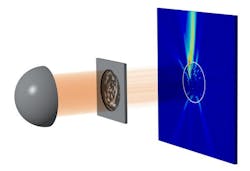Vienna, Austria--Vienna University of Technology (TU Vienna) scientists have developed a method to steer the radiation emitted by a random laser (http://www.laserfocusworld.com/articles/print/volume-48/issue007/world-news/random-laser-produces-speckle-free-images.html) into a pre-determined direction. What started out as a curious idea now has the potential to become a useful new type of light source.
The light emitted by random lasers is as unique as a fingerprint: random lasers are tiny devices with a light emission pattern governed by random scattering of light. "A random laser works without any mirrors," explains professor Stefan Rotter from the Institute of Theoretical Physics at TU Vienna. "It consists of a granular material in which light is randomly scattered and forced onto complicated paths." Along these paths the light is amplified. At which position it eventually exits the laser depends on the random inner structure of the laser material.
While ordinary incoherent light is pumped into a normal laser and converted into ordered, coherent laser light radially emitted in all directions, Stefan Rotter says, "Our idea is to pump the laser not uniformly, but rather with a specific pattern, which is optimized such as to generate exactly the laser beam we want." The pumping pattern selectively stimulates certain regions of the random laser, which then cooperatively produce light emission in a very well defined direction.
To determine the right pumping pattern that leads to the desired laser beam, the scientists used computer simulations. "We start with a randomly generated initial pumping pattern and calculate the resulting laser emission. The pumping pattern is then adjusted step by step until the laser sends out light in exactly the desired direction," says Rotter. As all random lasers are different, this optimization process has to be carried out for each device individually; but once the solution is known, the same laser beam can be created again and again. In principle, one could also steer the laser beam from a given direction to any other direction by changing the pumping pattern appropriately.Stefan Rotter's team is cooperating with a research group in Paris, where random lasers are fabricated and studied in the lab. Together, the researchers now want to test their findings in the experiment. If the experimental results indeed show that random lasers can be forced to relinquish their randomness, this would constitute a major step towards technological applications of these exotic new light sources.
SOURCE: TU Vienna; http://www.tuwien.ac.at/en/news/news_detail/article/8311/
About the Author

Gail Overton
Senior Editor (2004-2020)
Gail has more than 30 years of engineering, marketing, product management, and editorial experience in the photonics and optical communications industry. Before joining the staff at Laser Focus World in 2004, she held many product management and product marketing roles in the fiber-optics industry, most notably at Hughes (El Segundo, CA), GTE Labs (Waltham, MA), Corning (Corning, NY), Photon Kinetics (Beaverton, OR), and Newport Corporation (Irvine, CA). During her marketing career, Gail published articles in WDM Solutions and Sensors magazine and traveled internationally to conduct product and sales training. Gail received her BS degree in physics, with an emphasis in optics, from San Diego State University in San Diego, CA in May 1986.

